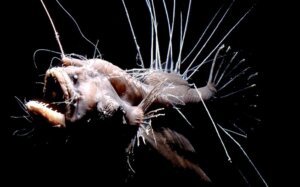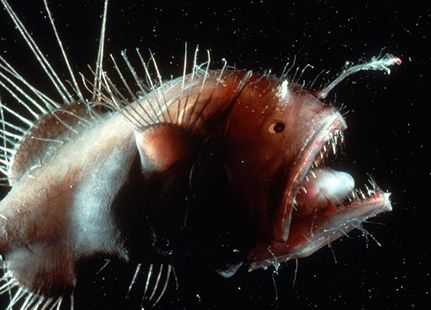The Striated Frogfish

The striated frogfish has different names, depending on the region where it’s found. It’s a very striking and interesting fish, due both to the way it captures its prey and its camouflage capacity.
Also known as the hairy frogfish, its official name is the Antennarius striatus. The name “Antennarius” derives from the Latin “antenna“, referring to the appendage from which the bait hangs.
The name“striatus” makes reference to the banded pattern present on the fish’s body.
The striated frogfish is a small-sized animal, whose shape resembles an inflated balloon.
General characteristics

Its body has a pattern of stripes and oval spots, with shades varying from white to black. It tends to be predominantly beige with dark bands on the different forked spines, as it doesn’t have any scales.
The length of the striped frogfish ranges from 5 to 40 centimeters (2 to 16 inches). On the other hand, this fish doesn’t have ocelli, a rudimentary visual organ they can perceive light with.
One of the most striking features of this species are the pectoral fins, which resemble the front legs of a toad, and the dorsal fin. Another curious feature is the transformation of the dorsal fins into three spines, elongating the front spine, and acquiring the shape of a fishing line.
This front spine is similar to a fishing rod and has a lure on the end. The lure used by this species to deceive its prey is shaped like a worm.
There are several species of frogfish that are classified according to the shape of the lure. The lure may resemble a shrimp, a small fish with fins and an eye, a worm, or a crab.
The lure consists of between 2 and 7 appendages. In addition, should the striped frogfish lose the lure, it will regenerate.
A certain sexual dimorphism can be perceived among the individuals of this species. Males have more widespread cutaneous appendages on their bodies than females.
Habitat and distribution
The striated frogfish is widely distributed, being found in diving regions such as Indonesia, the Philippines, Borneo, and other parts of Asia. It’s also present in the Atlantic Ocean, off the African coast, and on the American coast, including the Bahamas, the Gulf of Mexico, and the Caribbean.
The striated frogfish is always found in marine regions with tropical climates. It isn’t an easy animal for divers to detect, as they’re very good at camouflaging themselves.
Also, this species is most commonly found at depths of about 40 meters (130 feet), although it can be found anywhere between 10 and 200 meters (30 to 650 feet). Therefore, it’s a benthic animal that cohabits marine bottoms.
This species is found on sandy and rocky bottoms, as well as in coral reefs and estuaries. Being in this marine environment, they can camouflage themselves more easily, waiting for unwary prey.
Feeding
The striated frogfish has a big appetite, and it’s able to gobble up fish of the same size as them. The technique it adopts to attract prey is to lure them with its worm-shaped lure.
When prey is very close to it, it opens its mouth, unhinges its jaws, and generates a large suction. This suction draws all the water in front of the face of the striped frogfish, as well as the unwary fish swimming nearby.
Finally, when the prey is already in its mouth, the teeth close over them preventing them from escaping. Large prey are caught with their teeth and slowly driven inward.
If there’s no prey nearby, it may search for them, approaching entrances to shelters or nooks and crannies. Once at the entrance, it floats bait next to or above the entrance.
Since the striated frogfish doesn’t have a swim bladder, it moves using the impulse generated from the gills. Specifically, it emits a jet of water through its gill slit.
This fish has been seen to “yawn”, and it’s believed that yawning allows it to reposition its jaws after ingesting food.
Curiosities

The striated frogfish has been classified as an animal at low risk of extinction by the International Union for Conservation of Nature (IUCN). It seems that the only threat this species faces is the destruction of its habitat, as human interest only lies in keeping them in aquariums.
This species is characterized by being very resilient and capable of doubling its population in less than 15 months. However, we must support the preservation of all species, as well as this peculiar fish.
The striated frogfish has different names, depending on the region where it’s found. It’s a very striking and interesting fish, due both to the way it captures its prey and its camouflage capacity.
Also known as the hairy frogfish, its official name is the Antennarius striatus. The name “Antennarius” derives from the Latin “antenna“, referring to the appendage from which the bait hangs.
The name“striatus” makes reference to the banded pattern present on the fish’s body.
The striated frogfish is a small-sized animal, whose shape resembles an inflated balloon.
General characteristics

Its body has a pattern of stripes and oval spots, with shades varying from white to black. It tends to be predominantly beige with dark bands on the different forked spines, as it doesn’t have any scales.
The length of the striped frogfish ranges from 5 to 40 centimeters (2 to 16 inches). On the other hand, this fish doesn’t have ocelli, a rudimentary visual organ they can perceive light with.
One of the most striking features of this species are the pectoral fins, which resemble the front legs of a toad, and the dorsal fin. Another curious feature is the transformation of the dorsal fins into three spines, elongating the front spine, and acquiring the shape of a fishing line.
This front spine is similar to a fishing rod and has a lure on the end. The lure used by this species to deceive its prey is shaped like a worm.
There are several species of frogfish that are classified according to the shape of the lure. The lure may resemble a shrimp, a small fish with fins and an eye, a worm, or a crab.
The lure consists of between 2 and 7 appendages. In addition, should the striped frogfish lose the lure, it will regenerate.
A certain sexual dimorphism can be perceived among the individuals of this species. Males have more widespread cutaneous appendages on their bodies than females.
Habitat and distribution
The striated frogfish is widely distributed, being found in diving regions such as Indonesia, the Philippines, Borneo, and other parts of Asia. It’s also present in the Atlantic Ocean, off the African coast, and on the American coast, including the Bahamas, the Gulf of Mexico, and the Caribbean.
The striated frogfish is always found in marine regions with tropical climates. It isn’t an easy animal for divers to detect, as they’re very good at camouflaging themselves.
Also, this species is most commonly found at depths of about 40 meters (130 feet), although it can be found anywhere between 10 and 200 meters (30 to 650 feet). Therefore, it’s a benthic animal that cohabits marine bottoms.
This species is found on sandy and rocky bottoms, as well as in coral reefs and estuaries. Being in this marine environment, they can camouflage themselves more easily, waiting for unwary prey.
Feeding
The striated frogfish has a big appetite, and it’s able to gobble up fish of the same size as them. The technique it adopts to attract prey is to lure them with its worm-shaped lure.
When prey is very close to it, it opens its mouth, unhinges its jaws, and generates a large suction. This suction draws all the water in front of the face of the striped frogfish, as well as the unwary fish swimming nearby.
Finally, when the prey is already in its mouth, the teeth close over them preventing them from escaping. Large prey are caught with their teeth and slowly driven inward.
If there’s no prey nearby, it may search for them, approaching entrances to shelters or nooks and crannies. Once at the entrance, it floats bait next to or above the entrance.
Since the striated frogfish doesn’t have a swim bladder, it moves using the impulse generated from the gills. Specifically, it emits a jet of water through its gill slit.
This fish has been seen to “yawn”, and it’s believed that yawning allows it to reposition its jaws after ingesting food.
Curiosities

The striated frogfish has been classified as an animal at low risk of extinction by the International Union for Conservation of Nature (IUCN). It seems that the only threat this species faces is the destruction of its habitat, as human interest only lies in keeping them in aquariums.
This species is characterized by being very resilient and capable of doubling its population in less than 15 months. However, we must support the preservation of all species, as well as this peculiar fish.
All cited sources were thoroughly reviewed by our team to ensure their quality, reliability, currency, and validity. The bibliography of this article was considered reliable and of academic or scientific accuracy.
-
MNE. Antennarius striatus [Internet]. Monaco Nature Encyclopedia. 2018 [citado 13 de marzo de 2020]. Disponible en: https://www.monaconatureencyclopedia.com/antennarius-striatus/?lang=es
-
Antennarius striatus (pez sapo rayado o estriado, pez sapo peludo – pez sapo / rape: clave de identificación, comportamiento, rango, hábitat, fotos / clave de identificación, características, comportamiento, ocurrencia, distribución, fotos [Internet]. [citado 13 de marzo de 2020]. Disponible en: https://www.frogfish.ch/species-arten/Antennarius-striatus.html
This text is provided for informational purposes only and does not replace consultation with a professional. If in doubt, consult your specialist.








